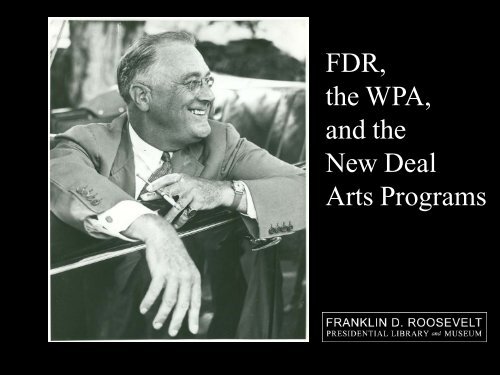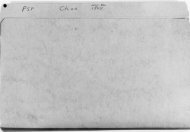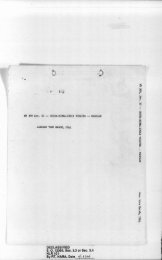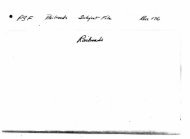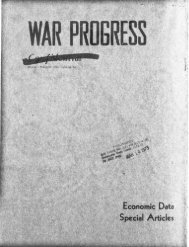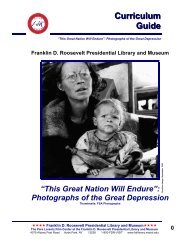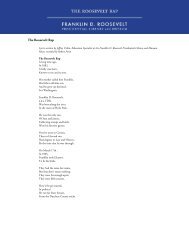FDR, the WPA, and the New Deal Arts Programs - Franklin D ...
FDR, the WPA, and the New Deal Arts Programs - Franklin D ...
FDR, the WPA, and the New Deal Arts Programs - Franklin D ...
You also want an ePaper? Increase the reach of your titles
YUMPU automatically turns print PDFs into web optimized ePapers that Google loves.
<strong>FDR</strong>,<br />
<strong>the</strong> <strong>WPA</strong>,<br />
<strong>and</strong> <strong>the</strong><br />
<strong>New</strong> <strong>Deal</strong><br />
<strong>Arts</strong> <strong>Programs</strong>
Special Thanks<br />
to Nick Taylor for his generous permission<br />
to use photographs <strong>and</strong> data from his book<br />
The Enduring Legacy of <strong>the</strong> <strong>WPA</strong><br />
American-Made:<br />
When <strong>FDR</strong> Put <strong>the</strong> Nation to Work<br />
Visit Nick Taylor’s website:<br />
www.nicktaylor.us
President <strong>Franklin</strong> Delano Roosevelt took office at <strong>the</strong> depth of <strong>the</strong><br />
depression. He used modern techniques, including “fireside chats” on<br />
<strong>the</strong> radio, to communicate new hope to <strong>the</strong> American people.
Millions were jobless, with no way to eat but breadlines<br />
like this one in <strong>New</strong> York City.
A Volunteers of America soup kitchen in Washington, D.C.
Many of <strong>the</strong> homeless lived in shantytowns derisively called<br />
“Hoovervilles.” This one was in Sacramento, California.
Drought <strong>and</strong> dust storms were ano<strong>the</strong>r mark of <strong>the</strong><br />
depression. This wall of dust bore down on Rolla, Kansas in<br />
May 1935.
Roads <strong>and</strong> o<strong>the</strong>r segments of <strong>the</strong> nation’s infrastructure dated<br />
to <strong>the</strong> horse-<strong>and</strong>-buggy era. The entire country needed work.
The Civil Works Administration (CWA) was <strong>the</strong><br />
Roosevelt administration’s first major work program.<br />
These men are working on a road in San Francisco.
Harry Lloyd Hopkins headed <strong>the</strong> Works Progress<br />
Administration (<strong>WPA</strong>) <strong>and</strong> its predecessor, <strong>the</strong> CWA.
From its advent in 1935, <strong>the</strong> <strong>WPA</strong> employed <strong>the</strong> majority<br />
of its workers in construction.
<strong>WPA</strong> workers building a connecting road between two<br />
highways in Lawrence County, Tennessee.
Children had to walk to school along this road in Fredrick County,<br />
Maryl<strong>and</strong>, before <strong>WPA</strong> repairs allowed it to be used by vehicles.
The <strong>WPA</strong> employed women in sewing rooms in almost every<br />
city <strong>and</strong> small town. This one was in Louisville, Kentucky.
Outlets like this one in St. Louis, Missouri, distributed <strong>the</strong><br />
products of <strong>WPA</strong> sewing rooms to clients on relief.
Librarian Doro<strong>the</strong>a Asher looks on as soldiers at Fort Belvoir,<br />
Virginia, check selections at <strong>the</strong> bookmobile operated by <strong>the</strong><br />
Fairfax County <strong>WPA</strong> Library Extension Project.
<strong>WPA</strong> “packhorse librarians” delivered books <strong>and</strong> magazines by<br />
horse, car, <strong>and</strong> boat to isolated rural areas. This rider is<br />
working in Knott County, Kentucky.
A <strong>WPA</strong> traffic safety worker guards children at a dangerous<br />
intersection in Connersville, Indiana.
The <strong>WPA</strong> worked at malaria prevention, as in this swampy<br />
mosquito-breeding area near <strong>the</strong> center of Southington, Connecticut.
The same area after it was converted to a free-flowing canal<br />
by <strong>the</strong> <strong>WPA</strong>.
The Beaver Dam School in Bleckley County, Georgia, served<br />
African-American children. This is <strong>the</strong> school in 1935.
The Beaver Dam School in 1936 after renovation by <strong>the</strong> <strong>WPA</strong>.
When <strong>the</strong> Ohio River flooded in January 1937, <strong>the</strong> <strong>WPA</strong> mustered nearly<br />
200,000 workers to save lives <strong>and</strong> property, <strong>and</strong> clean up afterward. A<br />
<strong>WPA</strong> official takes flood workers’ applications in Louisville, Kentucky.
The flood also created refugees along <strong>the</strong> Mississippi. This <strong>WPA</strong> school,<br />
in Memphis, Tennessee, is set up with cots to serve young children.
Flood victims being inoculated by <strong>WPA</strong> health teams in<br />
Memphis, Tennessee.
The <strong>WPA</strong> used native materials whenever possible. These women<br />
made mattresses out of Spanish moss in a Savannah, Georgia, program.
A coal fire had burned under <strong>New</strong> Straitsville, Ohio, for more<br />
than fifty years when <strong>the</strong> <strong>WPA</strong> began firefighting efforts. These<br />
workers are removing flammable material from a mine shaft.
<strong>WPA</strong> craft workers built <strong>and</strong> repaired toys, which were <strong>the</strong>n<br />
borrowed from “libraries” like this one in Atlanta, Georgia.
These boys are turning in shoes to be repaired by a <strong>WPA</strong><br />
shoemaker at <strong>the</strong>ir school in Asbury Park, <strong>New</strong> Jersey.
The <strong>WPA</strong> not only built Oregon’s Timberline Lodge, but <strong>WPA</strong><br />
craft workers made all its furnishings <strong>and</strong> decorations.
“I see one-third of a nation ill-housed, ill-clad, ill-nourished,” said<br />
Roosevelt in his second inaugural address. Students in this<br />
Washington, D.C., school lunchroom are eating hot lunches<br />
prepared <strong>and</strong> served by <strong>the</strong> <strong>WPA</strong>.
<strong>WPA</strong> workers like this entomologist at <strong>the</strong> Natural History<br />
Museum in San Diego, California, supplemented <strong>the</strong> staffs at<br />
museums <strong>and</strong> o<strong>the</strong>r public institutions.
Archeological digs employed <strong>WPA</strong> labor, including this<br />
excavation at <strong>the</strong> site of <strong>the</strong> Odessa meteor crater in Ector<br />
County, Texas.
Eleanor Roosevelt was active in virtually all aspects of <strong>the</strong> W.P.A.’s work<br />
She is shown here visiting a nursery school, Des Moines, Iowa, 1936.
The new Southside Bridge at Charleston, West Virginia, opened<br />
in 1937, is one example of <strong>the</strong> <strong>WPA</strong>’s rebuilding of <strong>the</strong> national<br />
infrastructure.
<strong>New</strong> York City lacked its own commercial airport before <strong>the</strong> <strong>WPA</strong><br />
built La Guardia Field, which opened in December 1939.
The <strong>WPA</strong>-built San Antonio River Walk converted a crime- <strong>and</strong><br />
litter-infested area into an attraction for tourists <strong>and</strong> locals.
A downhill skier photographed above <strong>the</strong> <strong>WPA</strong>-built<br />
Timberline Lodge.
A driving lesson being conducted on <strong>the</strong> Ohio State University golf<br />
course designed by Perry Maxwell <strong>and</strong> constructed by <strong>the</strong> <strong>WPA</strong>.
Young divers take <strong>the</strong> plunge at this <strong>WPA</strong>-built pool in Carbon<br />
Hill, Alabama.
The <strong>WPA</strong> turned to defense-related work as <strong>the</strong> threat of war<br />
grew closer. The laboratory worker waters a guayule plant<br />
being tested as a possible rubber source at <strong>the</strong> California<br />
Institute of Technology in Pasadena.
The <strong>WPA</strong> helped <strong>the</strong> United States solve a shortage of aircraft<br />
mechanics as World War II approached. Trainees J. D. Oliver<br />
<strong>and</strong> Charles Steele work with instructor L. P. French at Meacham<br />
Field in Fort Worth, Texas.
After World War II began with <strong>the</strong> Japanese bombing of<br />
Pearl Harbor, <strong>WPA</strong> artists produced posters such as this<br />
one urging <strong>the</strong> conservation of coal in wartime.
Art in America has always belonged to <strong>the</strong> people <strong>and</strong> has<br />
never been <strong>the</strong><br />
<strong>New</strong><br />
property<br />
<strong>Deal</strong><br />
of an academy<br />
<strong>Arts</strong><br />
or a class. The<br />
great Treasury projects, through which our public buildings<br />
are being decorated, are an excellent example of <strong>the</strong><br />
continuity of this tradition.<br />
The Federal Art Project of <strong>the</strong> Works Progress Administration<br />
is a practical relief project which also emphasizes <strong>the</strong> best<br />
tradition of <strong>the</strong> democratic spirit.<br />
The <strong>WPA</strong> artist, in rendering his own impression of things,<br />
speaks also for <strong>the</strong> spirit of his fellow countrymen<br />
everywhere. I think <strong>the</strong> <strong>WPA</strong> artist exemplifies with great<br />
force <strong>the</strong> essential place with <strong>the</strong> arts have ain a democratic<br />
society such as ours.<br />
<strong>Franklin</strong> D. Roosevelt<br />
Radio Address Dedication of <strong>the</strong> Museum of Modern Art,<br />
<strong>New</strong> York City, May 10, 1939.
Four <strong>New</strong> <strong>Deal</strong> <strong>Arts</strong> <strong>Programs</strong><br />
Four <strong>New</strong> <strong>Deal</strong> <strong>Arts</strong> <strong>Programs</strong><br />
• Public Works of Art Project<br />
• Section on Painting <strong>and</strong> Sculpture<br />
• Treasury Relief Act<br />
• Works Projects Administration Federal Art<br />
Project
Treasury Secretary Henry Morgenthau, Jr.
The First Federal Art Program<br />
Public Works of Art Project (PWAP), a crash relief<br />
program administered without a strict relief test<br />
in <strong>the</strong> Treasury Department. It lasted six months<br />
from December 1933 to June 1934, employed<br />
about 3700 artists, <strong>and</strong> cost about $1,312,000.
George Biddle,<br />
“The Expectant Thistles”
Eleanor Roosevelt with Edward Bruce, administrator of <strong>the</strong> PWAP,<br />
<strong>the</strong> first federal arts program, with Forbes Watson, art critic,<br />
<strong>and</strong> Lawrence Roberts, director of <strong>the</strong> Brooklyn Museum, 1933.
James Scott, “Hudson Highl<strong>and</strong>s,”<br />
Milton, <strong>New</strong> York, PWAP 1934.<br />
Collection of <strong>FDR</strong> Library <strong>and</strong> Museum
Ceil Rosenberg, “Snowy Days,” Chicago,<br />
PWAP, 1934.<br />
Collection <strong>FDR</strong> Library <strong>and</strong> Museum.
The Section of Painting <strong>and</strong> Sculpture, later called <strong>the</strong><br />
Section of Fine <strong>Arts</strong>, was <strong>the</strong> second program, also<br />
administered by <strong>the</strong> Treasury Department. It obtained<br />
painting <strong>and</strong> sculpture to decorate new federal buildings,<br />
largely post offices <strong>and</strong> court houses, by anonymous<br />
competitions. Inaugurated in October 1934, it faded away in<br />
1943. It awarded about 1400 contracts <strong>and</strong> cost about<br />
$2,571,000.
“Postal Workers Sorting Mail,”<br />
Ariel Rios Building, Federal Triangle,<br />
Washington, DC.
The Treasury Relief Act (TRAP) financed in July 1935 by an<br />
allocation of funds from <strong>the</strong> <strong>WPA</strong> to <strong>the</strong> Treasury for <strong>the</strong><br />
decoration of federal buildings, was administered by <strong>the</strong> Section<br />
according to <strong>the</strong> same relief rules as was <strong>the</strong> <strong>WPA</strong>. It employed<br />
about 446 persons, 75 percent of whom were on relief. It cost<br />
$833,784 <strong>and</strong> was discontinued in 1939.
Olin Dows, a Hudson Valley friend <strong>and</strong> neighbor of <strong>FDR</strong>,<br />
adminstered TRAP. He was also <strong>the</strong> East Coast director of<br />
<strong>the</strong> PWAP.
Olin Dows,<br />
Mural in <strong>the</strong> Rhinebeck Post Office
Interior of <strong>the</strong> Rhinebeck Post Office
The Work Progress Administration’s Federal Art Project<br />
(<strong>WPA</strong>/FAP), was part of a wider program called Federal<br />
Project No. 1, which included drama, music, <strong>and</strong> writing.<br />
It started in August 1935, was administered according to<br />
<strong>the</strong> relief rules of <strong>the</strong> <strong>WPA</strong>, lasted until June 1943, <strong>and</strong><br />
cost about $35,000,000. Slightly over 5,000 persons were<br />
employed at its peak.<br />
Harry Hopkins first employed artists on relief when he<br />
worked for <strong>New</strong> York’s Temporary Emergency Relief<br />
Agency under Governor Roosevelt in 1932.
Harry Hopkins watching John Kovacs at work on potter’s wheel at<br />
<strong>the</strong> <strong>WPA</strong>’s “Skills of <strong>the</strong> Unemployed Exhibition,” St. Louis,<br />
October 7, 1948.
Harry Hopkins joins Hallie Flanagan, head of <strong>the</strong> <strong>WPA</strong>’s Federal<br />
Theatre Project (wearing <strong>the</strong> wide-brimmed black hat), in a meeting<br />
with actors.
The <strong>WPA</strong>’s Federal Theatre Project dramatized current events in<br />
plays called “Living <strong>New</strong>spapers.” This is a scene from Triple-A<br />
Plowed Under.
Kate S<strong>and</strong>wine, <strong>the</strong> Strongest Woman in <strong>the</strong> <strong>WPA</strong> Circus,<br />
demonstrating her strength with a volunteer.
The <strong>WPA</strong>’s Federal Writer’s Project produced l<strong>and</strong>mark guides to<br />
every state <strong>and</strong> to major cities. They are promoted in this window<br />
display in Dawson’s Book Store in Los Angeles in 1941.
<strong>WPA</strong> deputy administrator Aubrey Williams, Women’s <strong>and</strong><br />
Professional Projects head Ellen Woodward, <strong>and</strong> Music Project<br />
Director Nikolai Sokoloff.
One of <strong>the</strong> musicians in <strong>the</strong> Detroit Community Dance B<strong>and</strong><br />
No. 13, sponsored by <strong>the</strong> <strong>WPA</strong>’s Federal Music Project, takes a<br />
solo spot at a night concert.
Alden Krider, “We Can Ill Afford to Lose <strong>the</strong><br />
Energy <strong>and</strong> Skill of These Young Men <strong>and</strong> Women,”<br />
National Youth Administration, Kansas, 1936.<br />
Collection of <strong>FDR</strong> Library <strong>and</strong> Museum.
Holger “Eddie” Cahill headed <strong>the</strong> Federal Art Project.
The <strong>WPA</strong>’s Federal Art Project sponsored community art centers<br />
like this one in Lynchburg, Virginia.
A <strong>WPA</strong> children’s class at <strong>the</strong> Walker Art Center in Minneapolis.
The <strong>WPA</strong> Pavilion at <strong>the</strong> 1939 <strong>New</strong> York World’s Fair. The mural,<br />
entitled “Work—<strong>the</strong> American Way,” was by Philip Guston.
Portl<strong>and</strong> artist Douglas Lynch created <strong>the</strong> murals in <strong>the</strong> Timberline<br />
Lodge coffee shop. The stools were h<strong>and</strong>-carved by <strong>WPA</strong> craftsmen.
<strong>WPA</strong> muralist Edward Laning <strong>and</strong> assistants work on <strong>the</strong> Ellis<br />
Isl<strong>and</strong> mural “The Role of <strong>the</strong> Immigrant in <strong>the</strong> Industrial<br />
Development of America.”
The lobby of Cook County Hospital in Chicago featured murals<br />
by Edwin Boyd Johnson, mosaic murals by John Winter, <strong>and</strong> <strong>the</strong><br />
figure at <strong>the</strong> center by Charles Umlauf. The polished stone<br />
benches were also by <strong>WPA</strong> craftsmen.
<strong>Franklin</strong> D. Roosevelt Presidential Library <strong>and</strong> Museum<br />
Hyde Park, <strong>New</strong> York
Homer Dana, “Mexican Mo<strong>the</strong>r <strong>and</strong> Child,” marble,<br />
California <strong>WPA</strong> Program, 1938.<br />
Collection of <strong>the</strong> <strong>FDR</strong> Library <strong>and</strong> Museum.
Print from <strong>the</strong> “Folk Art of Pennsylvania” Portfolio<br />
by Frances Lichten <strong>and</strong> Austin Davison, II.<br />
Collection <strong>FDR</strong> Library <strong>and</strong> Museum
Image from <strong>the</strong> “Portfolio of Spanish Colonial<br />
Design in <strong>New</strong> Mexico,” Federal Art Project of<br />
<strong>New</strong> Mexico, 1938.<br />
Collection of <strong>FDR</strong> Library <strong>and</strong> Museum.
Morris Topchevsky, “Line Men,” etching, Illinois<br />
Art Project.<br />
Collection <strong>FDR</strong> Library <strong>and</strong> Museum.
Paul Clemens, “In <strong>the</strong> Dugout,” tempera on<br />
masonite, Wisconsin Art Project, 1938.<br />
Collection <strong>FDR</strong> Library <strong>and</strong> Museum
Mitchell Siporin, “Prairie Poets” (Carl S<strong>and</strong>berg,<br />
Edgar Lee Masters, Vachel Lindsay with farm<br />
family), sketch for mural, Illinois Art Project, 1936.<br />
Collection <strong>FDR</strong> Library <strong>and</strong> Museum.
The W.P.A.<br />
650,000 miles of roads<br />
78,000 bridges<br />
125,000 civilian <strong>and</strong> military buildings<br />
800 airports <strong>and</strong> 700 miles of airport runways<br />
1500 nursery schools<br />
900 million hot school lunches<br />
225,000 concerts to audiences totaling 150 million<br />
Plays <strong>and</strong> performances to audiences totaling 30 million<br />
475,000 works of art<br />
276 full-length books
Ben Shahn, poster for Department of Agriculture,<br />
Resettlement Administration, 1935.<br />
Collection <strong>FDR</strong> Library <strong>and</strong> Museum.
There was a time when <strong>the</strong> people of<br />
this country would not have<br />
thought that <strong>the</strong> inheritance of art<br />
belonged to <strong>the</strong>m. . . . A few<br />
generations ago, <strong>the</strong> people of<br />
this country were often taught . .<br />
. that art was something foreign<br />
to America <strong>and</strong> to <strong>the</strong>mselves—<br />
something imported from ano<strong>the</strong>r<br />
continent, something from an age<br />
which was not <strong>the</strong>irs—something<br />
<strong>the</strong>y had no part in, save to go to<br />
see it in some guarded room on<br />
holidays or Sundays. . . .<br />
<strong>Franklin</strong> D. Roosevelt, Dedication of <strong>the</strong><br />
National Gallery of Art, March 17, 1941.


